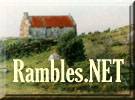| Stefan Grossman, Duck Baker & El McMeen, Mel Bay's Complete Celtic Fingerstyle Guitar Book (Mel Bay, 1995) I'm always skeptical when a musical instruction book calls itself "complete." What do they mean by that? How complete could one instruction book be, especially when as broad a topic as "Celtic fingerstyle guitar" is being presented? I have to admit that, while not literally "complete," this book provides a very comprehensive approach to Celtic music for the mid-level to advanced fingerstyle guitarist. I am very impressed. I will be working from this book and learning new things from it for years.
This instructional manual commences with a short article by each of the three authors. Each describes the musical pathway that brought him to this nexus, as they try to convey on the written page something that is most often taught as part of (for lack of a better term) an oral tradition. Each of the authors came to their love of Celtic music from a different angle, and each had numerous sources for the styles they eventually developed. It was as I read these introductory paragraphs that I began to sense that this just might in fact be a "complete" book. The "whole" that the authors collectively draw from does indeed combine to provide a rather complete picture. Next are articles on technique and an explanation of how to read tablature and the notations they have utilized to designate the use of particular techniques, such as hammering on, sliding and the use of harmonics. The material is divided into sections based on the types of tunes presented: airs, hornpipes, planxties, set dances, jigs, slip jigs, marches and Carolan compositions. These are presented in various tunings, from standard and dropped D to C-G-D-G-A-D, D-A-D-G-A-D and others. One rather unique feature is that there are different approaches to each piece. For example, "The Blarney Pilgrim" is presented in three different arrangements, each played with a different tuning and different right-hand ideas. This is yet another of the ways that this book lives up to its title -- I sincerely believe that, after I spend a year or two mastering all of the techniques presented, I will be able to tackle any sort of Celtic music that can be played on the guitar. And for guitar players of less than stellar ability, ideas on how to simplify an arrangement are often included. These can be more valuable than lofty ideas on how to create an exquisite arrangement that is beyond the musician's ability. When there are multiple arrangements of individual tunes presented, they generally range from simple to complex. This way, the authors have created a non-linear stair-step. The reader must thumb through the book to find arrangements written at the proper skill level, but it's not a difficult task. Even for the reader who cannot read music, by simply observing the density of those little black dots on the page, it's not too hard to figure out which are the most complex arrangements. The tablature is very helpful in this regard also. My own approach to music (or life for that matter) has never been a linear thing, so I found the way this book is designed to be quite compatible with my style of learning. As we enter each section, there is a short history and/or description of the tune, as well as advice on how to conquer particularly difficult sections. In addition to a CD enclosed with all the tunes contained in the book, there are also suggestions as to where the song can be found on commercially-available CDs. Finally, there are black and white photographs of the authors and of "Celtic Scenes" to help put the reader into the right mood. All in all, this is a wonderful book, and in spite of my initial doubts, I am convinced that mastery of the contents will allow the reader to confidently proclaim themselves to be a Celtic fingerstyle guitarist. That's a pretty good definition of "complete" as far as I am concerned. 
|
 Rambles.NET book review by Tim O'Laughlin 14 December 2001 Agree? Disagree? Send us your opinions!  



 |

